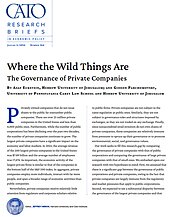Nevertheless, private companies receive relatively little attention from regulators and corporate scholars relative to public firms. Private companies are not subject to the same regulation as public ones. Similarly, they are not subject to governance rules and structures imposed by exchanges, as they are not traded on any exchange. Finally, since nonaccredited retail investors do not own shares of private companies, these companies are relatively immune from pressures to spruce up their governance or to promote environmental, social, and governance values.
Our work seeks to fill this research gap by comparing the governance of private companies with that of public corporations and comparing the governance of large private companies with that of small ones. We embarked upon our research with two hypotheses in mind: First, we assumed that there is a significant gap between the governance of public corporations and private companies, owing to the fact that private companies are largely immune from the regulatory and market pressures that apply to public corporations. Second, we expected to see a substantial disparity between the governance of the largest private companies and that of the smallest private companies since a similar gap was recently identified in research on public corporations.
To test our hypotheses, we established a data set about the companies on Forbes’s list of the largest private companies in the United States. Each company on the list has a revenue of at least $2 billion and employs thousands of employees. For each company in our data set, we collected data about the parameters that are often discussed in research on public corporations and that are considered the building blocks of good corporate governance: board diversity; diversity among top executives, including CEOs, chief financial officers (CFOs), and chief legal officers (CLOs); separation of the roles of CEO and chairperson; board size; and tenure of CEOs, CFOs, CLOs, and the chairperson. We then compared our findings with the data on public corporations.
To our surprise, our findings revealed no significant governance gap between the 200 largest private companies and public corporations. While we saw some differences on various metrics, the disparities are mostly insignificant. On most good governance metrics, private companies did as well as the flagship public corporations. Even regarding parameters for which we observed differences, such as CEO and chair tenure, these differences stemmed from a small number of outliers and tended to disappear when we compared medians instead of averages.
Furthermore, we observed no critical differences in the governance of the largest and smallest private companies in our sample. Even though the largest companies in our sample did better than the smallest ones on some metrics, we obtained the opposite result on other parameters, and there were no differences at all on most parameters. Overall, the 25 smallest companies in our sample did as well as the 25 largest ones.
After analyzing our results, we developed five theories to explain our surprising findings. The first explanation maintains that directors and officers in private companies adopt the norms of the business environment in which they operate and consequently hold themselves to the gold governance standards of public corporations. The second theory is that private companies desire to keep regulators at bay and avoid imposition of additional regulation. The third theory is that private companies are interested in attracting institutional investors and want to ensure that their governance appeals to the latter. The fourth theory is that private companies—especially large ones—intend to go public one day, which leads them to abide by the government metrics of public corporations. The fifth theory is that all corporations above a certain size—private or public—benefit from a similar governance structure.
Finally, we explored the policy implications of our findings. Concretely, we examined the need to impose additional regulation on the largest private companies and assessed the best ways to accomplish this. We conclude, however, that the present state of corporate governance in the 200 largest private companies does not establish a case for regulatory interventions. The best path forward is to continue to monitor and study the governance of the largest private companies to ensure that it remains in high standing. We believe that the threat of regulation is currently a more potent policy measure than actual interventions.
NOTE
This research brief is based on Asaf Eckstein and Gideon Parchomovsky, “Where the Wild Things Are? The Governance of Private Companies,” University of Pennsylvania Institute for Law and Economics Research Paper no. 23–15, April 5, 2023.

